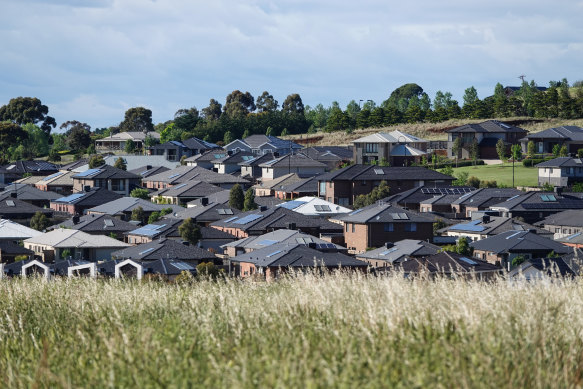- Exclusive
- Politics
- Victoria
- Victorian budget
This was published 1 year ago
Windfall gains tax will make $40m – but IT costs will suck up almost half that revenue
Almost half the revenue from one of Victoria’s new property taxes will this year be immediately eaten up by the cost of establishing the IT infrastructure needed to administer the charge.
The Allan government expects to reap $40 million in windfall gains tax during the 2023-24 financial year, according to the latest budget update. The levy, which came into effect July last year, applies to land valuations that jump $100,000 or more due to planning decisions.

Almost half the revenue from the government’s windfall gains tax will be eaten up this year by IT costs. Credit: Paul Rovere
However, the latest iteration of the government’s IT dashboard – which discloses cost overruns and delays for projects worth $1 million or more – states that $17.8 million will need to be spent on “the systems needed to support administration of this tax”.
The dashboard was recently updated after The Age revealed it hadn’t been refreshed in more than 12 months, despite being set up as a quarterly tracker. The transparency initiative labels projects green, amber or red. Green means a project is on time and on budget, amber means some issues exist, and red means major issues have been identified.
The infrastructure for the windfall gains tax, which is being implemented by the State Revenue Office, had its business case approved in February last year. Its original planned delivery cost was $14.1 million – meaning the overall cost has blown out by as much as $3 million.
“The project status is red due to uncertainty on costing/sizing of the stage two work, which will impact project budget,” the ICT dashboard states.
The windfall gains tax was just one of several property taxes flagged in last year’s state budget. Other measures included hiked land tax for people with second homes or investment properties, and an increased absentee owner surcharge.
The government said the land tax policy, which will be in place for 10 years, was part of a range of measures designed to help pay down Victoria’s COVID debt. The windfall gains tax bill, meanwhile, was introduced to parliament in October 2021 but only came into effect last year.
Economic modelling released in December warned that worse-than-expected consumer spending could delay Victoria’s return to surplus from the 2025-26 financial year to beyond the budget forecasting period. Net debt is also expected to hit $177.8 billion by mid-2027, which would represent about one-quarter of the state economy, according to the new budget predictions.
The ICT dashboard also shows that, for the final quarter of 2023, the long-awaited new case management system for the Magistrates’ Court and Children’s Court remained unfinished, despite having its business case approved back in 2017. The project is estimated to cost $89.23 million. Both courts potentially had recordings of hearings exposed as part of a recent hack.
Another project, designed to overhaul software at the Residential Tenancies Bond Authority, was revealed to have blown out by more than $1 million.
Shadow finance minister Jess Wilson, the Liberal member for Kew, said the updated project tracker proved Labor couldn’t manage money.
“Under Labor, millions of dollars continues to be wasted on botched IT projects across health, education, infrastructure, justice and community safety services as outcomes in these areas continue to decline,” she said.
“The mismanagement of the windfall gains tax software raises serious concerns about Labor’s ability to administer this tax in a timely, efficient and transparent manner.
“Spending almost half the new tax’s expected revenue on a software program to simply administer it is a wasteful use of taxpayer money and highlights the financial incompetence of the Allan government.”
But a Victorian government spokesman insisted the windfall tax project was on track to cost $15 million, not $17.8 million, according to current estimates.
“This one-off investment ensures we can collect the revenue due to the state, to benefit all Victorians, into the future,” the spokesman said.
“The system has been operating since July 1, when the windfall gains tax came into effect, and the overall project is on track to be completed this financial year more than $2 million under [the figure cited on the ICT dashboard].”
The Morning Edition newsletter is our guide to the day’s most important and interesting stories, analysis and insights. Sign up here.